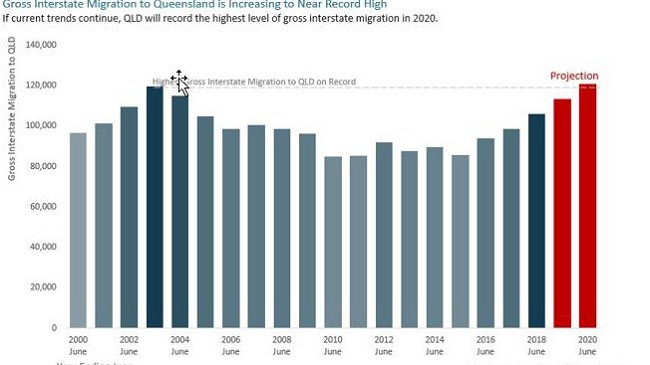
QUEENSLAND is on the cusp of a housing boom fuelled by Sydney and Melbourne’s property woes, with a leading analyst predicting interstate migration to hit a record high by next year — putting upward pressure on home prices.
New research by Place Advisory provided exclusively to The Courier-Mail forecasts gross interstate migration to the state could surge to more than 120,000 by the end of June 2020, if current trends continue.
That would surpass the level reached in 2002, which was a catalyst for double digit house price growth.

The number of southerners flocking to the Sunshine State is at its highest level in 14 years — and it’s not just because of our warm weather and world-class beaches.
Queensland recorded a gross interstate migration gain of 105,938 people in the 12 months to the end of June 2018, according to the latest Bureau of Statistics figures, with almost three quarters of them coming from Sydney and Melbourne.
The last period of decent home price growth in the state was between 2002 and 2008 when interstate migration was high and the economy was flourishing.
“We haven’t really seen real price growth since 2008,” “The floods in 2011 and 2013 really halted our marketplace, whereas the southern states have definitely seen significant capital growth.”
But he said that could be about to change, with a period of price growth in the range of around 7 per cent on the horizon.
“We’re relatively affordable now compared to everywhere else on the eastern seaboard and job opportunities are starting to arise, which should result in higher demand and higher prices.
According to the Real Estate Institute of Queensland, major infrastructure projects are forecast to inject $17 billion into Brisbane over the next six years.
“This sort of expenditure is boosting confidence, a key measure of market strengthening, among most property industry stakeholders,” REIQ chief executive Antonia Mercorella said.
Ms Mercorella said those projects were set to create nearly five per cent of the current employment levels in Brisbane during the construction phase alone, with flow-on employment upsides during the operating phase. She said that would likely result in a drop in the state’s jobless rate.